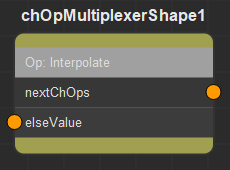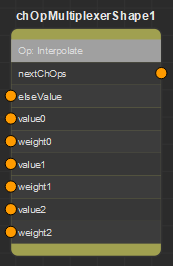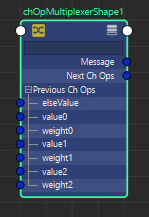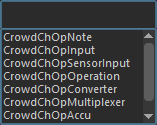ChOp Multiplexer
As of August 5th, 2025, Golaem will no longer provide direct support.
All support for Autodesk Golaem will now be handled exclusively through Autodesk support channels and this website will be deactivated soon.
Please bookmark the Autodesk Golaem Support section for any future support needs related to Autodesk Golaem packages.
The Channel Operator Multiplexer allows to combine values from previous Channel Operators (ChOps) into a single output value.


A Channel Operator Multiplexer seen in the Channel Operator Editor (left) and in the Maya Node Editor (right)
Note that the indices at which inputs are connected have different meanings (see image below):
- the PreviousChOps[0] is an else value
- all the following inputs are grouped by 2 where (i starting at 1 and always being an odd number).
- PreviousChOps[i] is a value
- PreviousChOps[i+1] is a weight associated to that value
To make it easier to remember, the values are aliased in the Channel Operator Editor and the Node Editor:


Previous Ch Ops inputs renamed according to their meaning
Creation
- From the Golaem Channel Operator Editor Tab key:

- From another Channel Operator:

- MEL command: addCrowdChOpMultiplexer;
Configuration
A Channel Operator Multiplexer defines the following specific attributes. For common attributes see Channel Operator Common Attributes.
Channel Operator Attributes

| Multiplexer Mode |
Defines how the various input are combined together.
|




